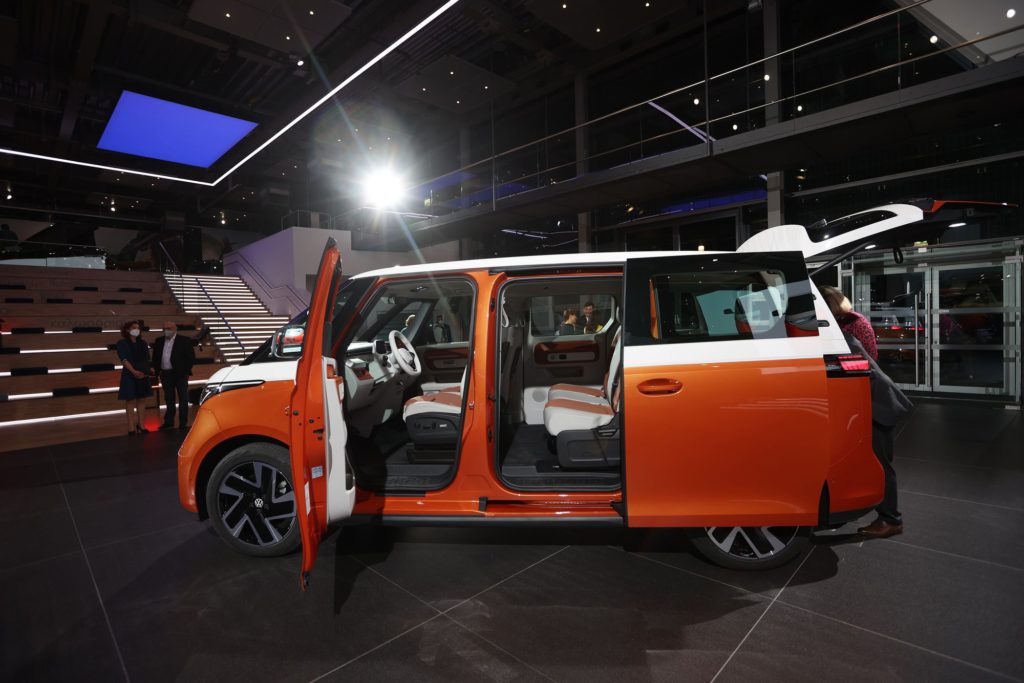(Bloomberg) —
It took almost 20 years, a step-change in driving technology, a diesel emissions scandal and a geopolitical gas crisis, but the Volkswagen bus is back, baby.
Volkswagen pulled the cover off the retro-bus Wednesday, a battery-powered van awkwardly dubbed the ID. Buzz. The cavernous machine will ship to European dealers later this year and can be configured for all kinds of Tetris situations, from smelly mattresses to surfboards and dog beds. With organic paint and vegan leather, it’s entirely on brand. American drivers won’t be able to slide into one until 2024, but rest assured they will be lining up for it shortly.
This van may kill the stigma of the electric vehicle as a compliance car — a cramped, eat-your-vegetables tool for a few crunchy consumers and corporations stretching to squeeze under emissions mandates. Sure, the GMC Hummer is now among us, with its 9,000-plus pounds and tank-driving tricks, but the camper-van is arguably an even more extreme use-case for electrification.
For one thing, its reason for being is the road trip. And the long road trip, in the U.S. at least, is still a bit constrained by limited charging infrastructure in rural areas. The #vanlife crowd isn’t commuting or heading to Costco; that’s for the Hummer bros. These rigs are bound for the beach and Burning Man.
Secondly, vans are not — and have never really been — hot-selling vehicles. Last year, Americans bought just 311,000 minivans, a rounding error in Detroit and 35% fewer than they did just five years ago.
Of course, a VW bus is a bit different. The company has cranked out about 7 million of them over the years and when Volkswagen stopped shipping new versions to America in 2003, it just keep churning on its own cult momentum. Indeed, the most treasured classic Transporters are fetching more than $200,000 these days.
None of this is lost on the suits in Wolfsburg. Car companies, in their heedless lust for so-called white space, are great at making gas-powered vehicles that few people want (see: Buick Cascada). The fact that they are finally doing so with electric vehicles is perhaps the strongest evidence to date that we’ve hit a tipping point in the battery-powered revolution.
Volkswagen has been teasing concepts of a new microbus for 21 years. It was the fifth CEO in that span who finally decided to steer one to the factory. But over the years, there was plenty of time for rivals to step. The jockeying for pole position in EV segments has warmed up lately. Car companies may be killing off their eccentric gas cars — the hatchbacks, convertibles and all things not SUV — but they are going all in on the evolution of the EV species.
Rivian produced the first electric pickup. Porsche has given us a battery powered station wagon. Things will only get weirder from here, as investor lust for all things electric confronts a brewing gas crisis. The green lighting of strange ideas will be fast and frequent.
Consider the Polestar O₂ that was recently unveiled. It’s a tiny electric sportscar with a removable roof and its own autonomous drone that can be slung skyward and ordered to follow the car and log video — a vehicle purpose-built for driving nuts with a strong TikTok game. In an industry ruled by conglomerates who never saw a focus group or scrap of supply-chain synergy they didn’t like, that’s as niche as it gets.
(Adds chart; adds reference in fourth paragraph to charging infrastructure in rural U.S. areas.)
More stories like this are available on bloomberg.com
©2022 Bloomberg L.P.











